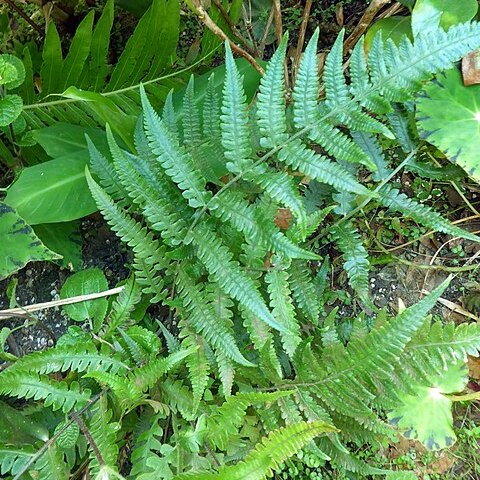Plants evergreen. Rhizome slender, creeping, dark brown, 2-5 mm in diam., apex with dense red-brown broadly lanceolate scales; fronds distant to approximate, variable, smallest ca. 6 × 1 cm, large fronds up to 1 m × 25 cm; stipe usually dark brown at base, upward stramineous, 2-40(-50) cm, 1-3 mm in diam. at base, with sparse pale brown to red-brown (rarely dark castaneous), broadly to narrowly lanceolate scales and curly nodose short hairs; lamina variable, usually broadly ovate-lanceolate or oblong-lanceolate, sometimes ovate, narrowly deltoid, or deltoid, up to 50 × 25 cm; free pinnae up to 10(-12) pairs below pinnatilobate apex, pinnae of small fronds often lanceolate or oblong-lanceolate, sometimes deltoid, ca. 5 × 1 cm, with only 1 or 2 pairs of free pinnae; pinnae of large fronds spreading or slightly ascending, subfalcate or sometimes straight, basal pinnae sometimes reflexed, shortly stalked or sessile, lanceolate or oblong-lanceolate, up to 15 × 3.5(-4) cm, base broadly cuneate or subtruncate, wider on acroscopic side than on basiscopic side, sometimes slightly auriculate, basal lobes not reduced or slightly so, usually broader, pinnatilobate or pinnatipartite, apex acuminate or long acuminate; pinnae of small fronds mostly ovate-rhomboid, obliquely ovate, or narrowly ovate, margin entire, repand, or shallowly lobed, apex rounded or acute; smallest pinnae ca. 5 × 4 mm; pinna lobes up to 15 pairs, subspreading, oblong, ligulate-elliptic, or falcate, margin entire, shallowly repand, or crenate, apex oblique, truncate, or acute, sometimes obtuse; veins pinnate with less than 7 pairs of veinlets, veinlets ascending, simple or forked, visible on both surfaces. Lamina herbaceous, green or gray-green to light yellow-green when dry, darker adaxially; abaxial side of rachis, costae, and veins hairy with many red-brown or yellow-brown to light gray-brown, long, nodose hairs, lamina between veinlets glabrous or with pale white nodose hairs, sometimes with few, brown, lanceolate scales; adaxial side of rachis, costae, and veinlets with short pointed nodose hairs. Sori shortly linear or linear-oblong, rarely J-shaped, less than 6 pairs per lobe, inframedial from veinlet base or near veinlet base to 2/3-4/5 of veinlet length, sometimes medial, single or double on basal acroscopic veinlets, covering entire surface of pinna lobes when mature; indusia gray-white when young, later brown or yellow-brown, membranous, glabrous or with short nodose hairs, margin lacerate, flat, not incurved. Spores semicircular in equatorial view, elliptic in polar view, perispore prominent, hyaline, with long clavate and aculeate projections. n = 80 (4´).
More
Stems creeping. Petiole dark brown or blackish at base, straw-colored distally, 10--30 cm, not swollen, teeth absent; scales pale brown, linear-lanceolate. Blade ovate-lanceolate, deeply pinnate-pinnatifid, 15--40 × 6--28 cm, moderately or slightly narrowed to base, broadest above base, abruptly narrowed to acuminate, pinnatifid apex. Pinnae oblong to linear-lanceolate, base ± truncate or broadly cuneate, apex acuminate to caudate; segments oblong, margins ± entire to serrate, apex obtuse or ± acute. Costae and veins with multicellular hairs. Veins pinnate, lateral veins usually simple, or sometimes forked in larger leaves. Sori elongate, straight or rarely hooked; indusia membraneous, margins laciniate.
A fern. It has creeping stems. They are slender and dark brown. The fronds vary in size from 6 cm x 1 cm to 1 m x 25 cm. They are deeply divided.

